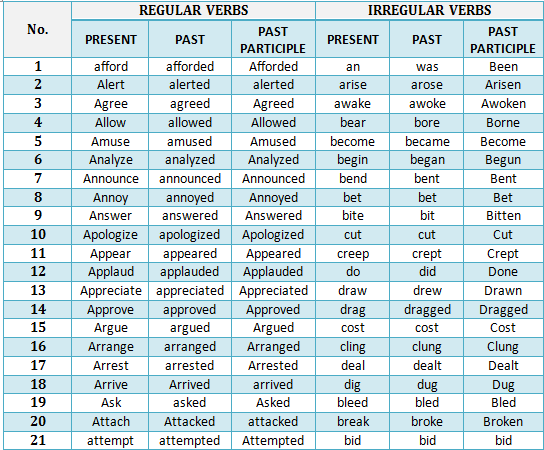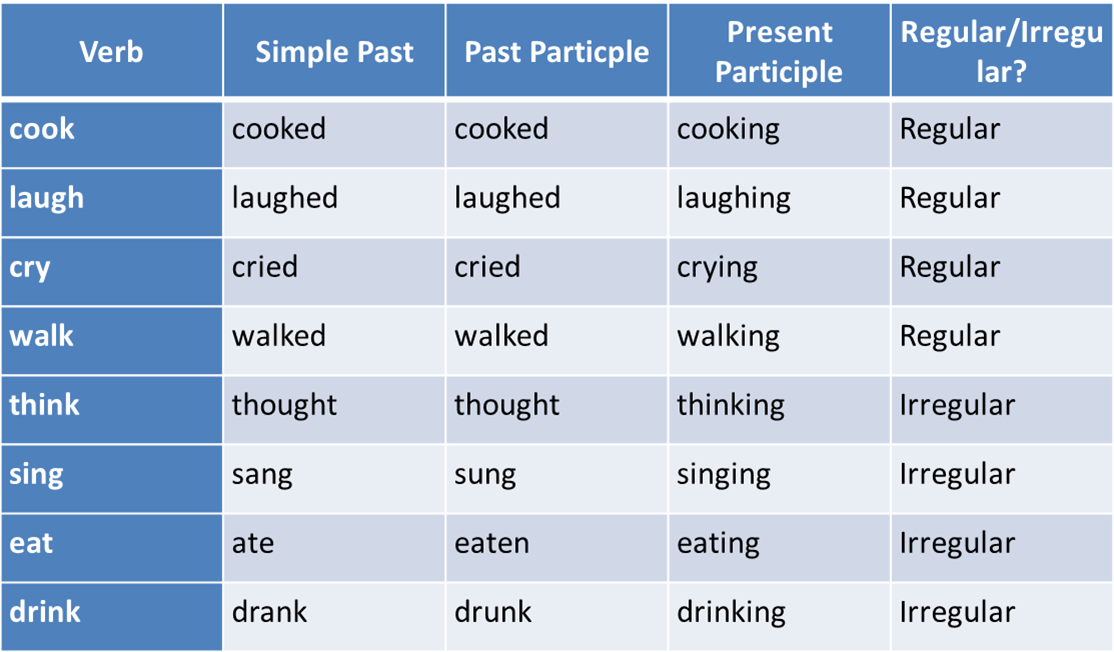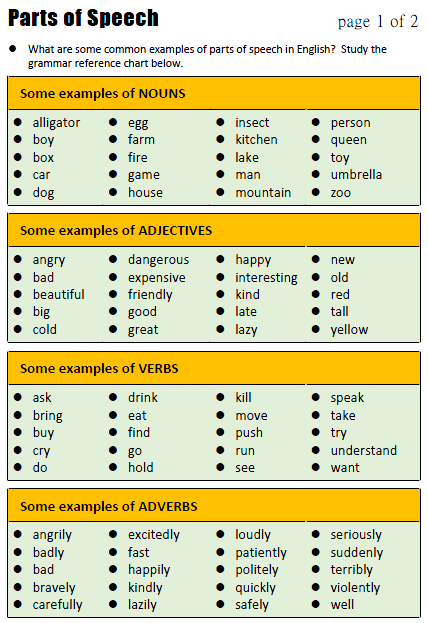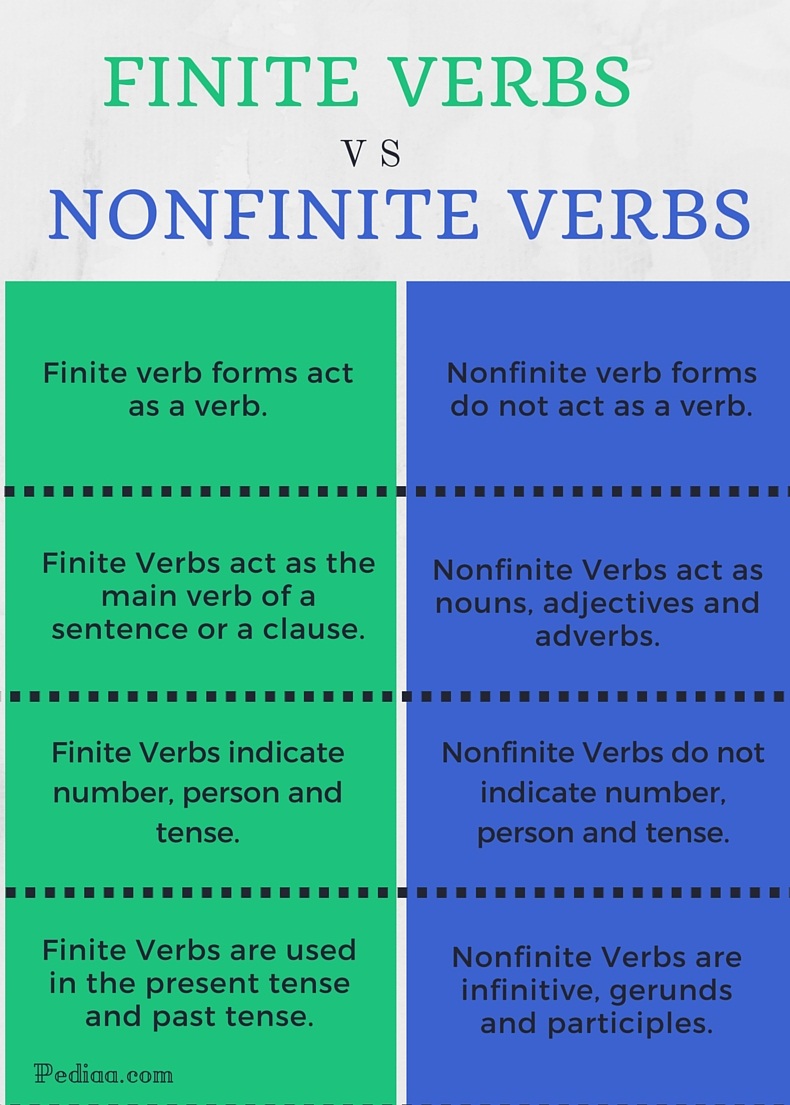The present participle after verbs of perception. The pattern for this usage is verb object present participle. There is a difference in meaning when such a sentence contains a zero infinitive rather than a. Present participles can function as nounsthe subjects, direct objects, indirect objects, objects of prepositions, and subject complements in sentences. Whenever a present participle functions as a noun, you call it a gerund. The best resource and help for ESL, EFL and English students and teachers. We have free English lessons, free lesson plans and can correct your essays. Some irregular verbs have the same past simple and past participle forms, but a different infinitive. Common English irregular verbs This is a list of over 180 common English irregular verbs, with their past simple and past participle forms. Present, Past and Past Participle Verbs. 2 (494 votes) Mon, 07: 51 Chris McCarthy Hide is the present tense, hid is the past simple and hidden is the past participle form of the verb. Have you ever flown in a helicopter? A participle, in grammatical terms, is the form of a verb that ends either in present participle, with ing, or in past participle, with ed. The word participle finds its origins in the Latin word participium, which means sharing, partaking, or participating. The present participle is often used when we want to express an active action. In English we add ing to the infinitive of the verb. Present participle, always ending in ing, is created from the form of a verb used with the verb to be (am, is, are, was, were, been) as an auxiliary verb (progressive tense). The Present participle is used. Present participles are an element in all continuous verb forms (past, present, future, conditional, etc. The helping verb will indicate the tense, while the present participle remains unchanging. Examples Participle Adjectives Long List Remember, we usually use the past participle (ed) to talk about someones feelings and the present participle (ing) to talk about cause of the feeling. past participle (ed) present participle (ing) alarmed alarming aggravated aggravating amazed amazing The present participle does not in itself indicate the time of the action that it refers to. However, it does show that this time is the same as the time of the preceding verb or the verb in the main clause: A number of verbs have irregular past participle forms. This list is not exhaustive by any means, but these are common verbs English speakers use every day. Lucky for you, English present participles, except for the occasional change from the letter y to the letter i, are fairly straightforward. PRESENT PERFECT TENSE (has, have past participle) to show an action that started in the past and continues to today or an action thats just happened. Example: I have attended ECC for two semesters. The French present participle of the verb is created by dropping the nous ending (ons) of the present tense verb and adding ant. For example: nous chantons becomes: chantant. Most often, it is used as an adjective, and must agree in gender and number with the subject being modified, but can also be used as a verb or gerund. A participle is a word formed from a verb which can be used as an adjective. The two types of participles are the present participle (ending ing ) and the past participle (usually ending ed, d, t, en, or n ). Verb tenses explained for primaryschool parents: present, past and future simple and continuous forms, with examples of use. Actually, this is for Primary School parents. but I as a german highschool Student still think this is very helpful. The past participle helps form the present perfect tense because this tense spans both the past and present. Regular past participles are formed by adding ed to the verb. The Search and Rescue team has recovered four lost hikers this year. Complete List of 638 English Irregular Verbs with their forms in different tenses. Mind Our English: Strong and weak by Ralph Berry English Irregular Verb List A comprehensive list of English irregular verbs, including their base form, past simple, past participle, 3rd person singular, and the present participle gerund. Complete 638 English Irregular Verbs List. This is the most complete list of English irregular verbs available on internet. It contains total 638 English irregular verbs with present participle (ing form of verb), simple past and past participle tense forms. The present continuous (also called present progressive) is a verb tense which is used to show that an ongoing action is happening now, either at the moment of speech or now in a larger sense. The present continuous can also be used to show that an action is going to take place in the near future. El present participle tras verbos de percepcin. En este uso, la estructura seguida es verbo objeto present participle. Cuando estas oraciones contienen un infinitivo sin to en lugar de un participio, el. Most present and past participle forms of verbs that describe emotion or feelings can be used as adjectives, but the meanings of the participles are not the same. For example: A fresh ocean breeze on a hot summer day is refreshing, so I feel refreshed. Present participles in Spanish are verb forms used to express continuous or ongoing actions. Spanish present participles end in ndo, which is the equivalent of the English ending ing. Check out the present participles in the examples below. What is the present participle? The present participle is a participle that ends in ing. It can be used with the auxilliary verb 'to be' to form the continuous tense. It always takes the ing form of the verb, even irregular verbs have an ing form, in fact virtually all English. To create a whquestion, start with the whword, then add am, is or are, then the subject (a person or thing that is doing the action), followed by the ing ( present participle) form of the verb and only then add the rest of the sentence. The French present participle, which always ends in ant, may be used as a verb, gerund, noun, or adjective. A number of verbs have irregular past participles, for example, 'break' past participle 'broken, ' and 'come' past participle 'come. ' Past participles are used to form perfect tenses and the passive voice, and many of them can be used like an adjective in front of a noun. Participle Adjectives Exercise 1 (based on the list above) Participle Adjectives Exercise 2 (based on the list above) Welcome to Perfect English Grammar! I'm Seonaid and I hope you like the website. Please contact me if you have any questions or comments. contact me if you have any questions or comments. To make the present participle of regular verbs: If the basic form of the verb ends in a consonant or a vowel other than e, add the ending ing (e. If the verb ends in e, drop the e before adding ing (e. A participle is a verb form that functions as an adjective by modifying nouns and pronouns. A participle can be either a present participle or a past participle. Participles are verb forms that have several functions. You already know that the present participle and the past participle forms of a verb are two of the five main verb forms. These forms of the verb are used when we need to form some of the different tenses of the verb. The present perfect is a verb tense which is used to show that an action has taken place once or many times before now. The present perfect is most frequently used to talk about experiences or changes that have taken place, but there are other less common uses as well. Present Participles in Participle Phrases It is really common to see present participles in participle phrases. A participle phrase also acts like an adjective. In the examples below, the participle phrases are shaded and the present participles are in bold. A Participle is a word which is partly a verb and partly an Adjective. Hearing the noise, the boy woke up. ; In the above example the word in bolds shows the characters of both a verb as well as an adjective thus it is a participle. The present and past participles can be used as adjectives. When used in this way, they are sometimes called participial adjectives and the present participle has an active meaning, while the past participle usually has a passive meaning. A present participle is a verb form (or verbal)made by adding ing to the basethat often functions as an adjective. Present participles are the only verb forms that are completely regular. The present participle (also known as the ing form) is used with a form of the auxiliary be to express the progressive aspect. For a discussion of the differences between present participles and. Have you ever noticed some English words with hyphens between them? For example: a wellknown author, an Englishspeaking country, a threehour movie. These are called compound adjectives meaning an adjective that has two or more words. In this lesson, you're going to. A participle phrase will initiate with a past participle or present participle. A participle is a verb form that actions as an adjective by modifying both the nouns and pronou ns. A participle can either be a present participle or a past participle that includes the participle, plus any modifiers and accompaniments. The Participle Phrase Recognize a participle phrase when you see one. A participle phrase will begin with a present or past participle. If the participle is present, it will dependably end in ing. Likewise, a regular past participle will end in a consistent ed. Irregular past participles, unfortunately, conclude in all kinds of ways [although this list will help. Past participle is one of the five verb forms, which include, infinitive, simple present, simple past, past participle, and present participle. Simple Present, Simple Past and Present Perfect Tenses This is a list of Irregular Verbs. I will read the base form, the simple past tense and the past participle of the verb. Then, I will read the verb in three sentences, a simple present tense sentence, a simple past The present participle, also known as the ing form, is a form of a verb that can be used as an adjective, as part of a participial phrase, or to show continuous action or perception. Past participles are simply one of those principal parts of a verb. Here is a chart showing you some examples of verbs broken into their principal parts. Present Other examples of present participles include swimming, laughing, and playing. The present participle can function as an adjective and modify nouns in sentences. For example, in the sentence The winning athlete gets a trophy, the present participle winning describes the noun athlete. present passive participle: there are some isolated cases or remnants of the present passive participle, such as the word [lakom (greedy); past active participle: there is only one remnant of the past active participle, which is the word [biv (former). The present participle of most French verbs (regular and irregular) is formed by dropping the ons ending from the nous form of the present tense and simply adding ant, as shown in Table 1. The line through the ons part of the nous form indicates that it is removed to form the present participle. Definition, Examples of English Past Participles Past participle definition: A past participle is formed from a verb and modifies a noun, noun phrase, verb, or verb phrase. Present Continuous Tense ISAMARE Present Participle Rules Examples in Hindi Please watch all the videos in sequence from playlist 1 to 14: Playlist 1. The perfect participle indicates completed action. You form the perfect participle by putting the present participle having in front of the past participle. In traditional English grammar, a participle is a verbal that typically ends in ing (the present participle) or ed (the past participle). By itself, a participle can function as an adjective (as in the sleeping baby or the damaged pump)..











